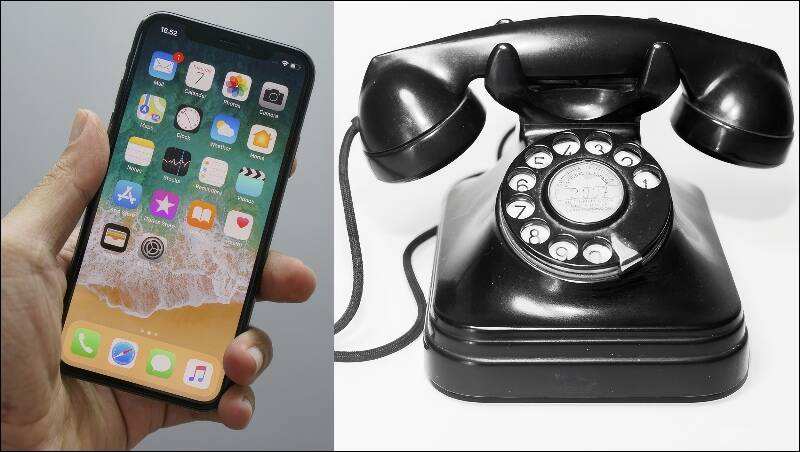On February 22, hundreds of thousands of Americans got a rude shock.
Their phones did not work. No voice calls. No email. No social media. It wasn’t due to a natural disaster such as a fire or earthquake. Nor was the outage caused by a cyberattack. It was a software update gone wrong on the AT&T network. All of the affected phones were smartphones.
In keeping with VashonBePrepared’s current “Prepare in a Year” communications theme, let’s talk about the fragility of smartphones and our national cell phone networks.
There’s no question: Smartphones put lots of computer and communications power in your purse or pocket. You can email, text, shop, play games, get a ferry schedule, search for answers to your “just curious” questions, and get a fix on how to drive to where you want to go. You can do all that from wherever you are.
That’s why most Americans have moved to smartphones, abandoning those old clunky phones that tether you to the wall of your home. Around 75% of all American adults live in households that have no landlines, only wireless phones. Compare that to twenty years ago, when only 3% of American adults lived in wireless-only households.
However, smartphones have their drawbacks, a fact that became clear to lots of people on February 22. Our sophisticated smartphones require powerful, complex networks to do their magic. As communications engineers will tell you, the more complex a system, the more opportunities for its failure.
Many VashonBePrepared volunteers invest in landlines as well as wireless smartphones. At the risk of oversimplifying, there are two basic types of landline service, plus emerging satellite-based technologies.
- POTS stands for Plain Old Telephone Service. The POTS technology has been around and working reliably for more than a century. You subscribe to the service from your phone company. As long as the phone lines are operational and your handset does not require wall power, POTS will even work during a power outage. Do keep in mind that some phones require wall power — for example, wireless handset phones (roam phones).
- Cable-based telephones provide a type of landline, but the call is connected over the Internet and it isn’t self-powered like POTS. Cable-based telephones are more susceptible to power outages than POTS but provide an alternative to wireless that you may be glad to have one day. They use the same kind of telephones as POTS. The instruments plug into the back of your cable modem.
- There’s another option for you to consider, and it is very reliable if you have good backup power. StarLink and other satellite Internet services don’t depend on utility poles and cables that trees could knock down in a windstorm. Starlink does not yet offer telephone service, but it is possible to use WhatsApp, Skype, Zoom, and similar services to communicate over a satellite Internet connection.
The latest versions of some smartphones also include a backup emergency satellite communications feature that allows brief emergency texts as a way to call for help. It is worth learning what backup communication features your smartphone might already have.
After the AT&T network was restored, and many thousands of people regained their smartphone connections, dozens of articles appeared online to cover the ins and outs of landlines and how to manage outages. The technology site CNET.com published a series of informative stories which can be found here.
Next Up for Prepare in a Year: Your Household Action Plan
We’re about to move to month two of Prepare in a Year. You’ll be learning all about making household action plans. You and your family will work together on steps you would take in an emergency.
We hope you had success with this first month of the Prepare in a Year campaign and that you took the three main household communications steps:
- Designate a point of contact.
- Make contact cards.
- Sign up for emergency alerts.
Here’s a link to a previous VashonBePrepared communication that gives you details on all three.
Exploring Dementia and Alzheimer’s Disease
VashonBePrepared’s coalition partner Voice of Vashon has launched a new series of the IsAbled radio show produced by Dr. Steve Nourse. The first of the seven-part series answers questions about the nature of dementia and its different causes, including the ways people mix up the terms dementia and Alzheimer’s. Dr. Nourse’s practice focuses on special education and social work issues of persons with physical, mental, and sensory disabilities.
His guest on the first show is Dr. Brad Tyson, a neuropsychologist at the Evergreen Medical Center in Bellevue.
You can hear the series at VoiceOfVashon.org by clicking on the Shows tab and scrolling through the list of programs to IsAbled.
A Vaccine Study of 99 Million
Scientists have published the results of a historic COVID study that analyzed data from 99 million vaccinated patients around the world. It’s the largest such study in history. Their findings confirmed that “the benefits of vaccination substantially outweigh the risks” of rare side effects.
Researchers from the Global Vaccine Data Network used de-identified electronic healthcare data to track the rates of 13 brain, blood, and heart conditions after people received the Pfizer, Moderna, or AstraZeneca vaccine and compared the results to the rates that would have been expected in the population before the pandemic.
The study confirmed known rare links between Pfizer and Moderna mRNA vaccines and side effects such as myocarditis and pericarditis. It also confirmed an association between the AstraZeneca vaccine and rare incidences of Guillain-Barré syndrome. (The AstraZeneca vaccine was not used in the U.S.)
At the same time, the study authors say the results showed that a COVID infection increases the incidence of some rare conditions much more than a vaccine does.



